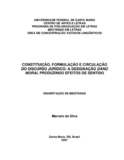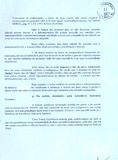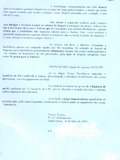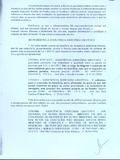| dc.creator | Silva, Marcelo da | |
| dc.date.accessioned | 2007-11-23 | |
| dc.date.available | 2007-11-23 | |
| dc.date.issued | 2006-12-11 | |
| dc.identifier.citation | SILVA, Marcelo da. Constitution, formulation and circulation
of the juridical discourse: the statement moral damage producing sense effects. 2006. 126 f. Dissertação (Mestrado em Letras) - Universidade Federal de Santa Maria, Santa Maria, 2006. | por |
| dc.identifier.uri | http://repositorio.ufsm.br/handle/1/9752 | |
| dc.description.abstract | The main objective in this work is to understand how the juridical practice, through the discursive relations established in a specific lawsuit, produces sense effects, and how the
same and the different relate to each other in the juridical discursivity. In order to do this, we have analyzed the processual rite of an indemnity ordinary action for losses and damages and moral damage, filed in the third civil jurisdiction of the judicial district of Santa Maria-RS, from the theoretical principles of French Discourse Analysis or according to a materialistic point of view. The analysis has as a starting point the designation moral damage and the corpus comprises the following lawsuit elements: initial petition, contestation, replication and sentence. From the necessary theoretical mobilization for the reflection and by means of analysis of the discursive corpus we can understand that this discursivity is organized in a way to try to regulate the meanings of moral damage. This happens from a particularization and generalization process which mediates the organization of the documents and intends to regulate the senses, creating an illusion of applicability of the rules of law to the conducts
presented in the documents. However, this language functioning is not free of imperfections, since ruptures and displacements happen in this attempt of regulation. This happens through the established game between two distinct forms of subject s individuation, called religious subject and subject-of-right (HAROCHE, 1992). On one side, we have the interchangeability, which aims at to support the regulation of the senses and the applicability of the law. On the other side, we have the expression of the subjectivity, which makes possible that the conducts presented in the documents be brought for discussion (making possible the discussion of exterior questions related to the legal system). We understand that even though the juridical discourse opens space for the movement of the senses, this is constituted in a
way to regulate itself. The juridical discourse is formulated and it circulates, respecting a series of rules that delimit what can and must be said, then supporting and legitimizing this
discursivity. | eng |
| dc.format | application/pdf | por |
| dc.language | por | por |
| dc.publisher | Universidade Federal de Santa Maria | por |
| dc.rights | Acesso Aberto | por |
| dc.subject | Dano moral | por |
| dc.subject | Discurso jurídico | por |
| dc.subject | Constituição | por |
| dc.subject | Formulação | por |
| dc.subject | Circulação | por |
| dc.subject | Moral damage | eng |
| dc.subject | Juridical discourse | eng |
| dc.subject | Constitution | eng |
| dc.subject | Formulation | eng |
| dc.subject | Circulation | eng |
| dc.title | Constituição, formulação e circulação
do discurso jurídico: a designação dano
moral produzindo efeitos de sentido | por |
| dc.title.alternative | Constitution, formulation and circulation
of the juridical discourse: the statement moral damage producing sense effects | eng |
| dc.type | Dissertação | por |
| dc.description.resumo | O objetivo deste trabalho é o de compreender como a prática jurídico processual, através das relações discursivas que se estabelecem em uma ação específica, produz efeitos de
sentido; como se relacionam, de maneira tensa, o mesmo e o diferente na discursividade jurídica. Para tanto, partindo de uma perspectiva materialista e dos princípios teóricos da
Análise do Discurso de linha francesa, analisamos o rito processual de uma ação ordinária de indenização por perdas e danos e danos morais, a qual correu na 3ª vara cível da
comarca de Santa Maria-RS. A análise tem como ponto de ancoragem a designação dano moral e o corpus de análise é composto pelas seguintes partes do processo judicial: petição
inicial, contestação, réplica e sentença. A partir da mobilização teórica necessária para a reflexão e da análise do corpus discursivo, podemos compreender que essa discursividade está organizada de maneira a tentar regular o sentido atribuído à designação dano moral. Isso acontece a partir de processos de generalização e de particularização que, regendo a organização das peças processuais, visam regular os sentidos, criando uma ilusão de aplicabilidade das normas jurídicas às condutas apresentadas nas peças. No entanto, esse funcionamento não é livre de falhas, uma vez que acontecem rupturas e deslocamentos nessa tentativa de regulação. Isso se dá através do jogo estabelecido entre duas formas distintas de individuação dos sujeitos, denominadas sujeito-de-direito e sujeito-religioso (HAROCHE, 1992). De um lado, temos a intercambialidade, a qual visa sustentar a
regulação dos sentidos e a aplicabilidadade da lei e, de outro, temos a expressão da subjetividade, a qual possibilita que sejam trazidas para discussão as condutas apresentadas nas peças processuais (possibilitando, assim, a discussão de questões exteriores ao sistema jurídico). Entendemos que o discurso jurídico, mesmo abrindo espaço para a movimentação dos sentidos, é constituído de forma a se auto-regular. Ao ser
formulado e ao circular, ele respeita uma série de regras que delimitam o que pode e deve ser dito, sustentado e legitimando essa discursividade. | por |
| dc.contributor.advisor1 | Scherer, Amanda Eloina | |
| dc.contributor.advisor1Lattes | http://lattes.cnpq.br/0683532681929143 | por |
| dc.contributor.referee1 | Sargentini, Vanice Maria Oliveira | |
| dc.contributor.referee1Lattes | http://lattes.cnpq.br/1406919572611392 | por |
| dc.contributor.referee2 | Silveira, Verli Fátima Petri da | |
| dc.contributor.referee2Lattes | http://lattes.cnpq.br/4907455690392249 | por |
| dc.publisher.country | BR | por |
| dc.publisher.department | Letras | por |
| dc.publisher.initials | UFSM | por |
| dc.publisher.program | Programa de Pós-Graduação em Letras | por |
| dc.subject.cnpq | CNPQ::LINGUISTICA, LETRAS E ARTES::LETRAS | por |






